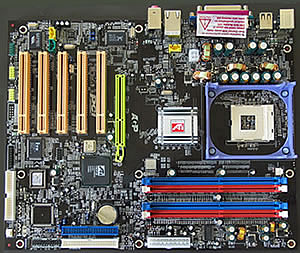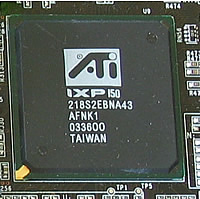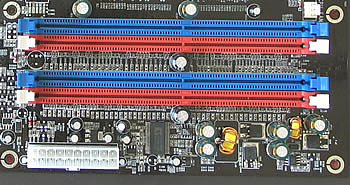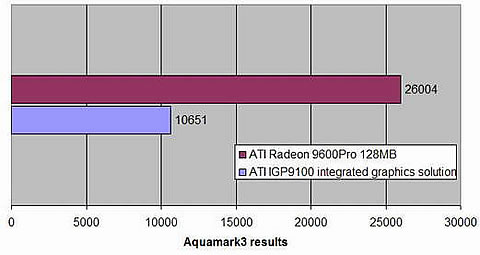1. Page 1
Sapphire - Axion 9100 review - Page 1
 Sapphire Axion RS300-AA38 is an all-in-one motherboard for Intel processors,
which uses a relatively new ATI chipset, namely the 9100 IGP. Saphire is a
graphics card manufacturer, and one of the biggest ATI partners in this category.
The board as we will see is mainly directed for low-cost solutions.
Sapphire Axion RS300-AA38 is an all-in-one motherboard for Intel processors,
which uses a relatively new ATI chipset, namely the 9100 IGP. Saphire is a
graphics card manufacturer, and one of the biggest ATI partners in this category.
The board as we will see is mainly directed for low-cost solutions.

 The Radeon IGP9100 a chipset that offers an integrated graphics core based
on the ATI Radeon 9200 GPU. Compared to the other boards with an integrated
graphics solution, its performance is more of a decent standard. It is fully
compatible with DirectX 8.1, and has TV-Out outputs.
The Radeon IGP9100 a chipset that offers an integrated graphics core based
on the ATI Radeon 9200 GPU. Compared to the other boards with an integrated
graphics solution, its performance is more of a decent standard. It is fully
compatible with DirectX 8.1, and has TV-Out outputs.
 The Radeon 9100 IGP chipset, codenamed RS300, was designed to support the
Pentium family of processors. Its specifications resemble the ones of the Intel
865’s, supporting models with 400/533/800 MHz FSB, and up to 2GB of memory
in dual channel mode. Hyperthreading processors are supported as well, and
with a firmware update with the latest BIOS from the company’s website,
Prescott cpus are supported too. Dual Channel mode memory configurations are
supported as well.
The Radeon 9100 IGP chipset, codenamed RS300, was designed to support the
Pentium family of processors. Its specifications resemble the ones of the Intel
865’s, supporting models with 400/533/800 MHz FSB, and up to 2GB of memory
in dual channel mode. Hyperthreading processors are supported as well, and
with a firmware update with the latest BIOS from the company’s website,
Prescott cpus are supported too. Dual Channel mode memory configurations are
supported as well.
2. Page 2
Sapphire - Axion 9100 review - Page 2
For the board itself, things are pretty standard. Along with the integrated
graphics adapter, you get an AGP 8x port if you decide to use an add-on graphics
card. There is a bracket that when connected, offers TV-Out and S-Video outputs.
You will find also 5 PCI slots, and 4 memory slots. Then there are the two
ATA 100 controllers, and a floppy controller. Close to the CPU socket is the
graphics chipset, cooled by a passive heat sink.

Moving to the back of the case, there is the VGA connector, two PS/2 connectors,
4 USB2.0 ports (total of 6, if installing the included bracket), 1 COM port
(total of 2 with a bracket, not included) and a LAN port. The Ethernet chipset
is from Realtek and it supports speeds up to 100 Mbps. There is an integrated
AC97 Audio codec chip also from Realtek that supports 2, 4 and 6 channel audio
configurations, selectable through software included in the bundled CD.

There are also 2 IEEE1394 connectors, but in order to be able to use them
you have to install the necessary bracket in the back. Same goes for the game
port, and the digital SPDIF output for digital sound. The brackets were not
included in the packaging. The board does not feature a Serial ATA controller
as well, but there is another flavor of the board that has it built-in for
those who want it.

Assembling our test system was a breeze. With everything being on board, we
only had to install the processor with the heatsink, add memory, attach the
board to the case with the necessary cables and we’re set to go.

When powering up and hitting the Del key, we are presented with the Phoenix-
Award BIOS, from where we can tune most of the settings. Unfortunately the
manual is quite far from the best we have seen, so less advanced users may
have a hard time here. While adequate, the BIOS lacks the advanced settings
some might expect.
 For example, if you were having thoughts about overclocking,
you can start thinking again. While offering some sort of option to increase
the FSB of the CPU, it is limited up to 15 MHz above the default FSB. Same
goes for the memory. In our tests we tried to overclock a 2.6 Pentium4 with
an increase of +7 or 8 and the system would end up not being able to POST at
all.The lack of control on the voltages of the CPU and the memory (Vcore and
Vdimm respectively) hindered any further attempts. This has not to do with
the BIOS though, don’t forget that probably the ATI chipset was not
designed for hard core overclockers. Nevertheless, the boards operation at
stock speeds
was very stable and unproblematic.
For example, if you were having thoughts about overclocking,
you can start thinking again. While offering some sort of option to increase
the FSB of the CPU, it is limited up to 15 MHz above the default FSB. Same
goes for the memory. In our tests we tried to overclock a 2.6 Pentium4 with
an increase of +7 or 8 and the system would end up not being able to POST at
all.The lack of control on the voltages of the CPU and the memory (Vcore and
Vdimm respectively) hindered any further attempts. This has not to do with
the BIOS though, don’t forget that probably the ATI chipset was not
designed for hard core overclockers. Nevertheless, the boards operation at
stock speeds
was very stable and unproblematic.
3. Page 3
Sapphire - Axion 9100 review
- Page 3
In terms of the performance of applications in Windows the IGP9100 chipset
copes quite well, but when compared it to many of the Pentium 4 motherboards
out there it still struggles to keep up with the competition. However, the
PCMark 2004 scores (3622) are satisfactory but not great. The performance could
increase with new BIOS releases and new drivers, since the IGP9100 is a relatively
new chipset.
Returning to the board’s strong points, the integrated graphics card “borrows” memory
from the main system memory in order to work. The amount can be set by the
BIOS, and can range from 32 to 128 Mbytes. So, if you have 256MB of ram and
a setting of 128 for the graphics card, the remaining available memory for
the operating system will be 128. Given the requirements of the modern operating
systems, this could hinder performance significantly. So when buying ram for
this board, you have to take this requirement into consideration.
One feature of the IGP9100 that could be of interest is an option to use the
integrated graphics together with an extra AGP graphics card. This would amount
to being able to have up to three displays with the same PC. This feature is
named Surroundview and can be configured via the bios. The only drawback is
that for this to work the extra card must be another Radeon based AGP card,
because ATi’s Catalyst drivers must be installed. While not something
to go head over heels with, this feature could be useful for example to some
people that need to build a cheap multi monitor solution.
As far as 3D performance goes the integrated graphics chip deals quite well
with older 3D applications. But with anything beyond DirectX 8 it would really
be a struggle. From the benchmarks that we ran the scores were not that exceptional.
We added a an Ati Radeon 9600 Pro reference card to our test system and ran
the same benchmarks in order to see the difference in 3D performance. The benchmarks
used where 3DMark 2001, and Aquamark3. The former performs tests up to DirectX
8, while the latter puts more stress into the cards using tests up to DirectX
9. The drivers used were the latest official ATI Catalysts version 4.5 which
support this chip as well. This ensures that there will be always room for
improvement, with the frequent driver updates ATI issues (almost once every
month the last months). The diagrams below summarize the results.


As we can see, the performance of the integrated graphics chip is lacking
compared to the one of the current “gaming” trends. This was expected,
since it is based on the “older” Radeon 9200 chip.
4. Page 4
Sapphire - Axion 9100 review - Page 4
All in all, the Saphire Axion RS300-AA38 is a product that targets a specific
audience. Sapphire may not have a long history in motherboard manufacturing,
but for a very long time it has been making graphics boards of good quality.
As
you can easily verify, there are a lot of better boards out there for the Pentium
family of processors, feature and performance-wise. One driving factor to get
the Saphire board is the price. Its retail price is in the range of 80-90 Euros,
and no extra graphics card is necessary to set up a good and stable system.
Yes, gaming will be almost out of the question, but I doubt any serious gamer
would rely on an integrated graphics card to cover her needs for high 3D performance.
If you’re looking for a motherboard to overclock your P4 like “no
man has gone before”, this board is not for you, either.
Putting newest (and always rising in demands of processing power) games and
hardcore overclockers aside, the graphics performance will be more than adequate
to watch movies on your monitor or TV, run desktop applications, play games
and so on.
This board could very easily power an office pc, and with all the extras
that are offered on board, you won’t have to buy any other card in order to
build a complete system. You could even get one of these boards and build around
it your own custom built HTPC!
Should you decide to go for it bear in mind a couple of things: if you need
features like SPDIF and IEEE1394 ports, purchase of the necessary brackets
is necessary since they are not included. If you have more than 2 ATA devices,
you will also need to buy an extra IDE cable, which we think should have been
included and not left out. Also plan ahead what your memory needs will be and
buy enough RAM, because with the shared memory that the integrated graphics
card requires, you might be ending up with 128Mbytes less of memory available
for your system.
Pros
- Ideal for low cost solutions
- Integrated DirectX8.1-compatible graphics
card
- Easy installation
Cons
- No or little overclocking (only 15 more than FSB)
- Cannot change Vcore or any other voltage
- To get good 3D performance for newer games you need an extra graphics
card
- Retail package is a bit poor (no SPDIF out bracket, 1 IDE cable only,
manual)
- Shared memory between graphics card and system needs to be taken into
account when buying RAM
Links
http://www.Sapphiretech.com
|
Advertising |
|
|